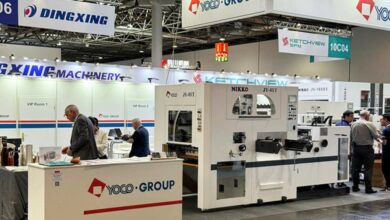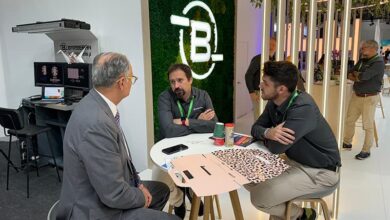“FESPA wants to Engage with The Middle East”
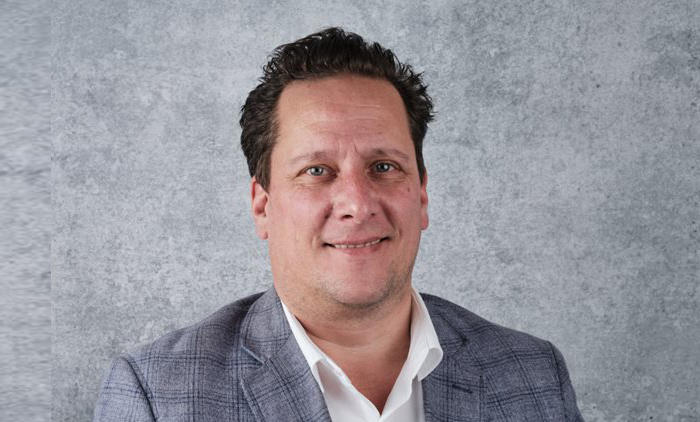
Exclusive Q&A Session with Neil Felton, CEO, FESPA
ME Printer recently caught up with FESPA CEO Neil Felton, where he elaborates about FESPA Middle East 2024, to be held from 29 to 31 January, 2024, at the Dubai Exhibition Centre, UAE. It is the first time FESPA ventures into the Middle East market, which in itself is a testament to the huge potential of ME region for everything print.
Felton lays out FESPA’s role in the global market growth, his views on the trends and markets in the Middle East, the challenges faced by the industry, new technologies, sustainability, and lots more.
As a frequent visitor to the Middle East, what would be the focus of FESPA Middle East 2024?
It’s a very different environment, a fascinating one, which I know quite well, but am looking forward to know more. Over the last 12 years, I’ve looked at the market very closely and what I find fascinating about the Middle East, particularly if we start with Dubai, is that actually they’re very forward thinking, very open to education and knowledge. I found that very much with the FESPA Leadership Exchange (FLEX), where we had some of the biggest printers in the region, talking about sustainability, AI, and a whole range of things.
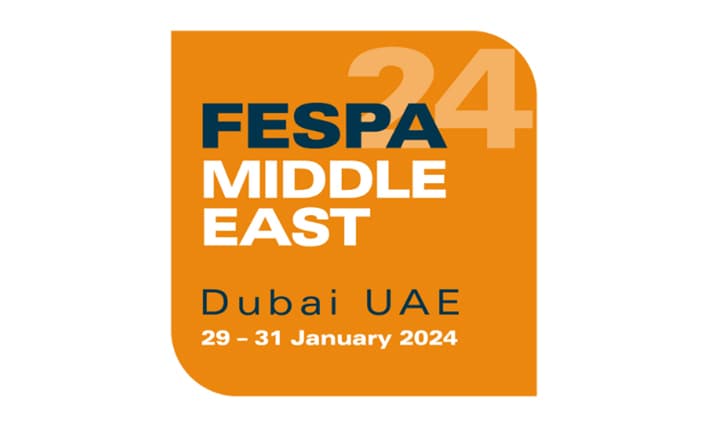
What is the core competency of FESPA?
FESPA is a non-profit organisation and we need to reinvest to build demand for print. Basically all of our profits are reinvested back into the industry. We are owned by the 37 associations and not by PLC or anything like that. Over the last seven years we have invested over 7 million euros back into the industry. We want to try and help the region build the demand for print and the opportunities that are available. That’s the most important thing as far as we’re concerned.
I think what the Middle East is really wanting is a show with editorial content, as a show with just advertising is not of much value to the printers. You need to have all the information about the products and the exhibitors, but you also need editorial content. That’s the key thing. We bring editorial content.
If you have been to previous editions of FESPA in Europe, you go and see ‘Printeriors’ or the ‘World Wrap Masters’, the FESPA Awards or the ‘Sustainability Spotlight’, or the whole range of educational information. We don’t make any money on those. Our purpose is to try and show to printers what the opportunities are, and that’s what we are going to get to the Middle East.
So looking at the financial model of FESPA, all the money that we make from events, exhibitions, and commercial activities are reinvested back into the industry.
COVID has had disastrous consequences. With FESPA, do you feel that the market is back or are you still feeling the effects of COVID?
Actually it’s not only COVID, but there’re many other factors. As an economist, if you look at the challenges, you have got Eastern Europe, problems with commodity prices, inflation, etc. So there’re a variety of factors which are affecting the global macroeconomic picture. With regards to FESPA, we’re very much back to what we were in 2019. This is very good news and shows that there’s a lot of demand in our industry for the activities that we do and the market is back now.
Could you throw some light on the competition between, say an event like SGI and FESPA, and do you think there is a place for a similar kind of exhibition?
I think the market will tell us whether there is or not. The indications that we get is that they want FESPA here. I won’t talk about SGI, that’s not really my place, but we already have information about what the exhibitors are saying. They want FESPA. They want a content-rich, powerful international organization to come and drive the market forward and FESPA is perfectly located for that. There’s a massive market in the Middle East and we want to help that market to grow. That’s our only motivation.
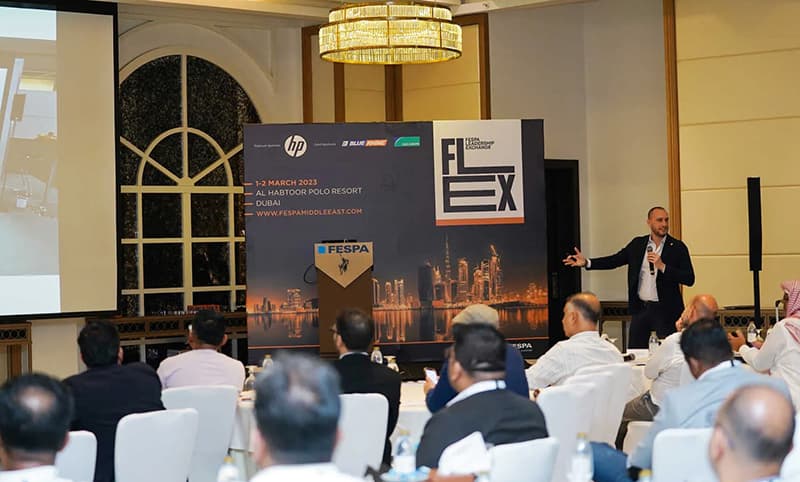
Recently you had the FESPA Leadership Exchange (FLEX) in Dubai. Can you give us a round-up of what happened?
The whole purpose was that we wanted to get leaders in the industry together and get them talking. We wanted to engage one another. In effect, it was driven. We had the Global Summit in Dubai in 2018 and it’s actually moving on from that and we need to do something similar for the region and have discussions. What we focused on was basically three things – sustainability, the future of the industry, and the amazing things that we are doing at our specialty print space.
We also did a SWOT analysis with all the printers in that room saying what the market’s strengths, weaknesses, opportunities, and threats are, besides engaging with each of those three key topics. So what came out of it was something very powerful. We managed to get around 30 most influential printers in the region, discussing the topics of the day and trying to get some executive summary about the main things they can do with their businesses, moving forward.
This is your first experience in the Middle East. So what kind of response do you expect to call the 2024 show a success?
I would call it a successful show if we hit our matrix target. But actually since the only driver is the visitors, we can think of an Explori survey. Normally FESPA is in the top five percent in the world with regard to exhibitions. If we can have such a survey where the visitors say what they needed and if we can be in the top 5 to 10 percent of exhibitions in the world, then I will be very, very happy. It’s unusual to do it for the first time, but that’s what we are going for. If the visitors are happy, the exhibitors are happy, and the press is happy.
The industry is faced with several challenges. Supply chain disruptions, pricing rise for consumables, automation, workflow, and others. Can a visitor to FESPA Middle East find a solution on how to deal with these challenges?
Visitors can try this in two ways. One is by speaking to suppliers whom we bring in there. We will be bringing not just the distributors from the region but heavy influence from head offices as well to actually find out from the OEMs, the substrates, and the inks specialists. The other one is that because we are talking more of a content-led networking type exhibition, they can find solutions from other exhibitors. So with challenges such as prices and cost of supply etc., the idea that we can put together is for them to find out more through networking and what other people are doing. We have around 14,000 exhibitors worldwide who are members of about 37 associations. In fact our membership went up in times of trouble since all of them had common problems, and what they did is they coalesced around an organization which could help them in such challenging times. Through FESPA Middle East, let us speak to one another and see how we could get through this together.
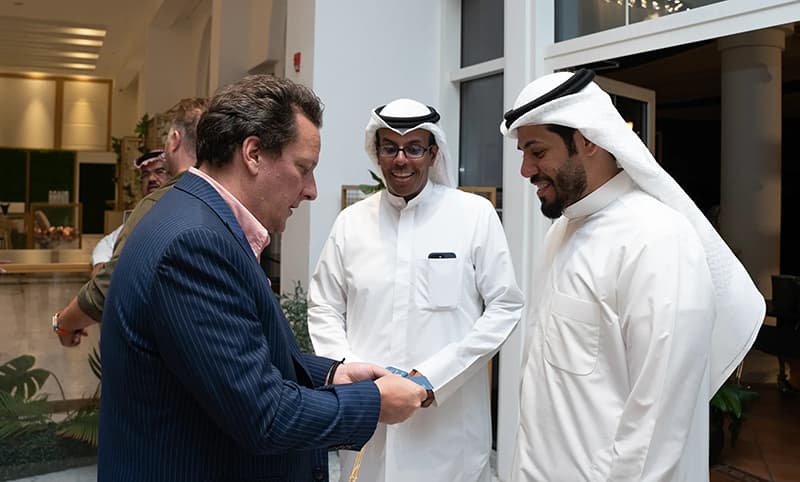
Middle East is a large region with many countries. It is not a homogenous region. Dubai is also a gateway to African countries through which you could also attract visitors from Africa. How would you cover all this vast geographical area as far as marketing is concerned, how would you reach out to all of them?
If you look at the region we’re are going at, it’s clearly shaped like a large oval that covers the GCC countries, goes to North Africa, south-east to Tanzania, and further north-east to India, Bangladesh, and Pakistan, with each of them having different needs. India, Bangladesh, and Pakistan are very powerful with regards to textile, and Bangladesh is massive with regard to screen printing. So we do have to offer different things and in FESPA we deal with each of these markets.
In textiles, we have a strong presence, particularly in screen printing and digital printing. If you’re looking at signage, with Dubai, Qatar, and Saudi, etc., we have a huge presence in soft signage and the more traditional type. Less developed markets are desperate for knowledge and therefore Dubai is a very logical place. Dubai is a gateway to the whole region, North Africa, GCC, and South Asia, to come across and engage with a wider group of people such as product managers, technical managers, etc. who play a huge role in influencing their company heads in taking a final decision. The fact that they can all come along and play with the equipment and look at the inks and the substrates and speak to other people within the industry is a powerful experience. So you’re talking about quite a broad swathe of information which all of them require for different needs which I believe FESPA can deliver as we have done for the last 60 years.
What are the industry trends and opportunities in the Middle East? Do you see any specific or particular need for our region?
I would see this in two levels. I see great similarities between the Middle East and Europe in ways like utilizing the market. We have a great deal of information about the region. Before bringing a show to a region, you need to understand the history, the politics, and the economics.
I believe in the definition of ‘geo-adapting’. For example, we run a show in Brazil which starts at 12 noon, something which will never work out in Europe, and if you apply the European model to Brazil, that wouldn’t work out either. Similarly Saturday is a very busy day, but never a busy day in Europe.
Our focus is on listening to the market and all the printers that we know through FLEX and Global Summits. We need to know what is expected. It needs to be driven by the region. The whole purpose of FESPA is to make the market grow for which we need to listen to the market and help it grow.
During past decades exhibitions have evolved. They are more focus now. Visitors to exhibitions nowadays prefer to see end to end printing workflow in action. For example Switzerland’s Hunkeler Innovationdays digital printing exhibition showcases not only machines but also solutions, where visitors can see the entire process. Will FESPA be having something similar, be it from different manufacturers and brands, and if so, will it give better results?
I completely agree with you and we have been exactly doing this for the last seven years or so. The largest show we had before COVID was in 2019 in Munich where we had a feature called ‘Print-Make-Wear’, which showcased the entire process – from fabric designing to fabric printing and finally turning them into clothes, with the whole factory on the show floor. You will see the same again in 2024 in Amsterdam with our ‘Sportswear Pro’ show. Similarly ‘Personalization Experience’ in Munich this year will be showing what we can do with print and how you can turn it into a product and what kind of profits you can make from it. We have done this for many years and we will be bringing it to Dubai.
A new trend seen especially in the Middle East is that commercial printers are moving into large format, signage, and even textile printing. Though FESPA traditionally deals with digital printers, would you be reaching out to commercial printing sector too in the 2024 Middle East show?
Without question. The same as we engage with commercial printers around the world, because the more forward thinking commercial printers realize that there is a very good market and a specialty print market that we operate, whether digital printing or text. The story remains the same whether in Europe, Brazil, or Turkey. What we’re seeing is that forward thinking commercial printers are moving into our space and they know that we’re their home for that. So it was nice for us because we had a whole new raft of visitors coming into our shows which wasn’t the case when they were thinking that digital printing was not part of their business. And now it is. This is the trend we’re seeing around the world, and we imagine it will be the same in the Middle East.
One important topic worldwide is sustainability, for which we all are responsible. Do you have any specific plan to promote sustainability in your show through visitors or programs?
We have a product called ‘Sustainability Spotlight’. It will be a digital product available to everybody on the show floor, giving examples of printers who have taken the sustainable route and how they have done it, what has been the outcome, etc. I think the best way to learn is to see examples set by other companies of what they’ve gone through. So we will be bringing an element of sustainability to our Middle East show.
It was also the central feature of FLEX where we spent nearly 30 to 40 percent of the program talking about sustainability. What is interesting about sustainability from a Middle East perspective is that you don’t have as many challenges as we have in Europe with regard to how you can become sustainable. But the beauty of it is that we have the best printers in the world, potentially in Europe, on sustainability, and we can bring their knowledge and information to the Middle East.
We have a President with an ISO 14001 after going through a process of nearly 10 years, and the idea that we can supercharge and change and help printers in the region to understand what they can do to become more sustainable within their environment, is indeed very powerful. My personal view is that in the next couple of years, brands will be asking more and more about sustainable printing and we want to help printers in the region to be able to do just that by providing them the required knowledge.
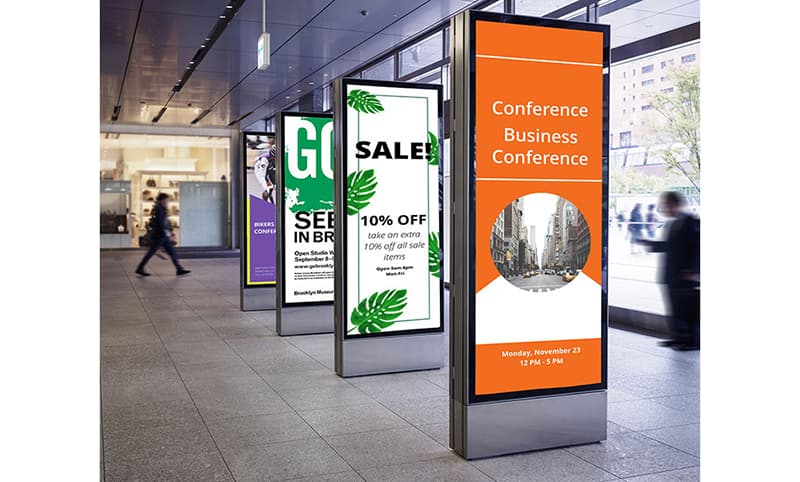
Electronic signage is also part of FESPA. How important will it be in the Middle East 2024 event?
It’s not as central, but it is a thing lot of our printers are doing. We had a printer called Alberto Massedotti in FLEX. Half of his business is digital signage and half is electronic signage. Having worked with IKEA and some of the really big brands in signage, his knowledge was very useful in FLEX. So we will be bringing that to Dubai. We are speaking to quite a few brands to see if they can go alongside FESPA. At the end of the day, we are a federation of associations which deals with the visual communication space, and digital and electronic signage are part of that space.
Another trend gaining momentum is experiential design which is becoming huge in the US, Europe, and even in the Middle East. Will we see this being highlighted at FESPA?
We have a product for maybe six years now called ‘Printeriors’. We have some incredible interior designs which cover tables, chairs, walls, and whatever you can print on, and how to make it look beautiful. I feel Dubai and the Middle East are probably the perfect places for it, with the level of design and the high quality, particularly in the UAE. I think we have a lot to show people on how print can bring a space to life. So I think ‘Printeriors’ will form part of what we do for the Middle East and to show the opportunities for interior design and experiential printing with regard to our market.
Do you expect major brands like Canon, HP, Xerox, etc. to be part of FESPA Middle East 2024?
Our discussions with major brands suggest that all of them will be there, whether direct or through their distributors. Middle East is a massive opportunity with growth potential and they would like to make sure of their participation. But the whole purpose of FESPA is to ensure the participation of all leading brands and that’s what we are going for.
There’s a lot of talk about AI. Will we see this type of technology in the Middle East show?
What we need to know is that AI is already part of everything, embedded in so many things we do. Even if we don’t realize it, AI has become part of our everyday existence. It will certainly affect a lot of the systems that people run. Even when we talk about the knowledge from ChatGPT to look up certain things, nothing beats face-to-face interaction.
When I first started exhibitions about 25 years ago, it was the birth of the Internet and we used to think that exhibitions are going to die due to the Internet. But in reality, Internet helped people make better decisions when they got to trade shows and made them realize the importance of personal interaction. Exhibitions have been around for thousands of years and they will continue to be, because humans are conditioned to learn from others. We want to engage.


